#Southern Fulmar
Text
Antarctica Dream Adventure 8 - Drygalski Fjord
This is our third day at South Georgia Island in our Antarctica Dream Adventure. South Georgia is the British Overseas Territory of South Georgia and the South Sandwich Islands.
As we progress on the expedition we are told that areas of South Georgia are being closed due to the detection of birds with avian influenza and to help reduce the spread of the disease. The expedition leader is…
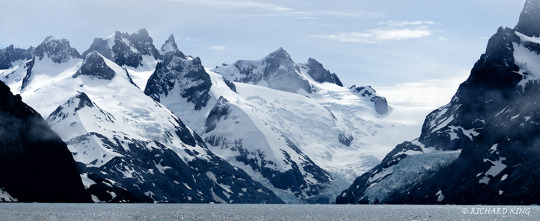
View On WordPress
#Antarctica#SnowPetrel#SouthernFulmar#SouthGeorgia#wildlifephotography#Z100-400S#Z24-70S#Z8#Antarctic Prion#Antarctic Shag#Antarctica Dream Adventure#British Overseas Territory#Drygalski Fjord#Fjord#glaciers#Iceberg Alley#Icebergs#Mountains#NIK 6 Silver Efex#Nikkor 24-70mm f/4 S#Nikkor Z 100-400mm f/4.5-5.6 VR S#Nikkor Z TC-1.4x#Nikon Camera Systems#Nikon Z 8#Richard King Photography#Snow Petrels#South Georgia and the South Sandwich Islands#South Georgia Island#Southern Fulmar
0 notes
Photo

A new variant has been added!
Southern Fulmar (Fulmarus glacialoides)
© Elizabeth Gould
It hatches from black, bluish, dark, distinctive, migrant, pink, regular, silvery, and white eggs.
squawkoverflow - the ultimate bird collecting game
🥚 hatch ❤️ collect 🤝 connect
0 notes
Text
Animal of the Day!
Southern Giant Petrel (Macronectes giganteus)

(Photo by Brian Sullivan)
Conservation Status- Least Concern
Habitat- Antarctica; Africa; Australia; Chile
Size (Weight/Length)- 99 cm; 205 cm wingspan
Diet- Squid; Krill; Carrion; Penguins; Seals
Cool Facts- Southern giant petrels are possibly the most malicious birds in the history of ever. While mostly eating squid and fish, they will not turn their beak up at a helpless seal pup or penguin. Graphic warning, the animals are often eaten alive. Yeah, nature isn’t always pretty. They are also known for holding down smaller birds like black-browed albatross and gannets underwater to drown them. Despite the horrors, Southern giant petrels are monogamous and are extremely protective of their chicks.
Rating- 9/10 (They’re called stinkers too.)
#Animal of the day#Animals#Birds#Sea birds#Tuesday#August 23#Southern giant petrel#Giant petrel#Fulmar#biology#science#conservation#the more you know
39 notes
·
View notes
Text

Royal Air Force Tactics During the Battle of Britain | Classic Warbirds
During the years preceding the Second World War (1939 - 1945), the prevalent idea that affected military thinking was, as Stanley Baldwin, leader of the Conservatives, stated in a speech in the House of Commons on the 10th November 1932 that “the bomber will always get through”, as it was envisioned that in a future war the enemy would deliver a knockout blow from the air. Limiting the damage enemy aircraft could do would be the responsibility of the Air Defence of Great Britain, which was established on the 1st January 1925, and was the component of the Royal Air Force tasked with defending the UK's airspace.
As the RAF expanded during the 1930s, on the 13th July 1936 the Air Defence of Great Britain was disbanded and replaced on the 14th July 1936 by three new commands, Bomber, Coastal and Fighter alongside Training Command, formed on the 1st May 1936. Fighter Command, with Air Chief Marshal Hugh Dowding as its Commander-in-Chief, was now responsible for the defence of the UK's airspace.
The tactics developed by Fighter Command, as part of its Air Fighting Manual, called for tight formations of three aircraft in a Vic formation to perform Fighter Area Attacks, of which there were six different scenarios to attack enemy aircraft, depending on the amount and type of aircraft intercepted. Once they spotted the hostile aircraft the squadron would position themselves according to the Fighter Area Attack chosen. However, this was based on the premise that attacking bombers would fly from airfields in Germany without effective fighter cover, which wouldn't be the case in the summer of 1940, as the Luftwaffe could operate from airfields in France.
Fighter Command Structure
When the battle began on the 10th July 1940, Fighter Command, whose headquarters were at Bentley Priory, was still commanded by Air Chief Marshal Hugh Dowding and was structured as follows:
No. 10 Group
Commanded by Air Vice-Marshal Sir C J Quintin Brand
Headquarters: RAF Box
Covering: South West England and South West Wales No. 11 Group
Commanded by Air Vice-Marshal Keith Park
Headquarters: RAF Uxbridge
Covering: South East England and London
No. 12 Group
Commanded by Air Vice-Marshal Trafford Leigh-Mallory
Headquarters: RAF Watnall
Covering: East Anglia, Midlands, Mid and North Wales No. 13 Group
Commanded by Air Vice-Marshal Richard Saul
Headquarters: RAF Newcastle
Covering: North England and Scotland
No. 14 Group
Commanded by Group Captain Philip F. Fullard (1)
Headquarters: Drumossie Hotel, Inverness
Covering: Scotland No. 9 Group (2)
Commanded by Air Vice-Marshal Wilfred McClaughry
Headquarters: RAF Barton Hall
Covering: Northern Ireland and North West England
1. Replaced by Air Vice-Marshal Malcolm Henderson on the 20th July 1940.
2. Formed on the 16th September 1940.
Aircraft Strength - 10th July 1940
Fighter Command had 656 fighters available, consisting of 29 Hawker Hurricane, 19 Supermarine Spitfire, 6 Bristol Blenheim and 2 Boulton Paul Defiant squadrons. It could also call on Nos. 804 and 808 Naval Air Squadrons, the former equipped with Gloster Sea Gladiators and the latter Fairey Fulmars, who were on loan from the Fleet Air Arm.
View the order of battle for Fighter Command on the 10th July 1940
The Luftwaffe could call on over 2,000 aircraft to begin their campaign to gain air supremacy over Southern England, one of the requirements for Operation Sealion the invasion of Britain to take place. Mainly comprising Messerschmitt Bf 109 and Bf 110 fighters, Heinkel He 111, Dornier Do 17 and Junkers Ju 88 twin-engined bombers and Junkers Ju 87 dive bombers.
Squadron Structure, Vic and Finger-Four Formation
During the battle, a typical Royal Air Force fighter squadron was to have twelve aircraft and pilots available for operations. The ideal number for the squadron was at least sixteen aircraft to cover those being serviced or out of action. To cover pilots who were on leave or unable to fly it was intended for the squadron to have at least 20 pilots to call upon, although at times some squadrons were unable to meet this number.
The squadron would be split into four sections (red, yellow, blue and green) with three pilots (one, two and three), with two sections making up one flight of aircraft. Each section, flying in Vic formation, was led by a section leader with two wingmen, with red and yellow normally making up 'A' flight and blue and green normally making up 'B' flight, with a colour and number identifying each aircraft. For example, as shown in the squadron structure diagram below, the red section leader would be known as red one.
Structure of a typical RAF squadron during the Battle of Britain
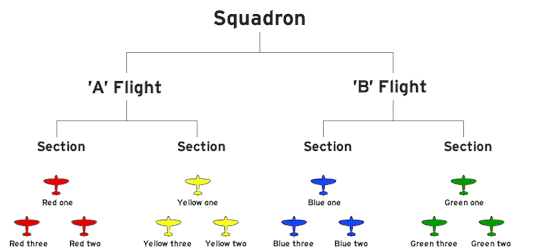
When the battle began, the Luftwaffe were able to operate from airfields in France, enabling their fighters to escort the bombers to Britain. So when the RAF and Luftwaffe met in the skies above Britain and the English Channel, the ineffectiveness of the Fighter Area Attack tactics and Vic formation was soon exposed. As with the required tight formation, only the lead aircraft of every Vic was able to search for enemy aircraft, as the other two aircraft in the Vic had to focus on keeping formation, so an attacking aircraft could catch the formation by surprise, particularly from the rear. Although the tactic was later modified so that the fourth section would fly 1,000ft above and behind the other three sections, whilst weaving, to help minimise the chances of an attack from the rear, casualty rates among these aircraft were high.
Typical RAF squadron formation during flight in the Battle of Britain
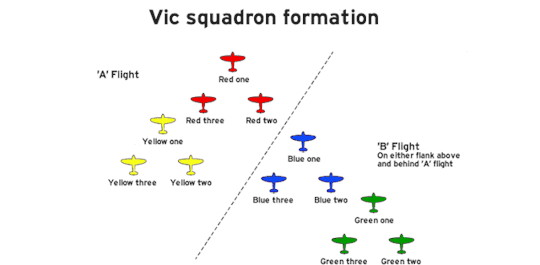
Despite complaints about the Vic formation, no official change was forthcoming, so some squadrons adapted a tactic being used by the Luftwaffe called Schwarm, which was a more flexible tactic. This had been developed after the combat experience of the Luftwaffe's Condor Legion in the Spanish Civil War (1936 – 1939) and would be called Finger-four by the RAF. This involved four aircraft flying in formation, but operating in pairs. This allowed the attacking aircraft to be covered by his wingman with the overall formation spaced at about 200 meters apart and flying at various altitudes. This meant the pilots could focus on looking for enemy aircraft and also protect each other, and if the formation was attacked the two pairs would split up, one going left the other to the right. The Finger-four tactic also meant that the squadron formation changed as it would now be divided into three sections of four as opposed to the Vic formation's four sections of three.
In the aftermath of the battle, Fighter Command modified its tactics in 1941, before, in 1942 the Finger-four formation was officially added to pilot training.
Finger-four squadron formation

Engaging the Luftwaffe
When an incoming raid had been plotted by Britain's Air Defence System, also known as the 'Dowding System' (see diagram below), squadrons would be scrambled by controllers as and when needed, as opposed to a large formation, allowing an enemy raid to be under constant harassment by the Royal Air Force which also had the effect of breaking up the Luftwaffe formations, however, fighter sweeps by the Luftwaffe were not a priority for Fighter Command.
Dowding System

The opening stages of the battle, during July and early August 1940, saw the Luftwaffe probe the Royal Air Force's defences by attacking shipping in the English Channel and targets along the coast. However, mid-August saw the Luftwaffe change tactics and launch Operation Eagle Attack on the 13th August 1940, known as Eagle Day, this saw the Luftwaffe try to lure the RAF into battle in the air by targeting Fighter Command's infrastructure.
Many tactical instructions were issued during the battle, and this new phase saw the first major tactical changes by Fighter Command when, on the 19th August 1940, Air Vice-Marshal Keith Park, Air Officer Commanding, No. 11 Group, Fighter Command, issued a number of instructions. Among these was for RAF fighters to operate only over land or gliding distance to the coast.
Despatch fighters to engage large enemy formations over land or within gliding distance of the coast. During the next two or three weeks, we cannot afford to lose pilots through forced landings in the sea.
And prioritising German bombers as targets.
Against mass attacks coming inland, despatch a minium number of squadrons to engage enemy fighters. Our main object is to engage enemy bombers.
Seven days later on the 26th August 1940, Air Vice-Marshal Keith Park issued further instructions to help with the interception of German formations, as not all squadrons sent to intercept were doing so. This would require details on the intercepted raid to be detailed over the radio to help controllers vector more squadrons to the correct area.
To enable Group and Sector Controllers to put all squadrons in contact with the enemy formation leaders are to report approximate strength of enemy bombers and fighters, their height, course and approximate position immediately on sighting the enemy.
One of the final major instructions issued by Air Vice-Marshal Keith Park was on the 11th September 1940 that when contact was made with the Luftwaffe formation, the Spitfires should tackle the fighter screen, whilst the Hurricanes concentrated on the bombers and close escort. However, as radar couldn't differentiate between the aircraft in a raid it wasn't always possible for this to happen.
READINESS SQUADRONS: Despatch in pairs to engage first wave of enemy, Spitfires against fighter screen, and Hurricanes against bombers and close escort.
By the time this instruction was issued, the Luftwaffe had again changed tactics and were targeting London and other cities across the UK, in what was to become known as the Blitz.
The Big Wing
The use of multiple squadrons for one large formation wasn't a completely new tactic for Fighter Command, as they had been used during Operation Dynamo (26th May 1940 - 4th June 1940) the evacuation from Dunkirk, France. The issue with these larger formations was if vectored to the wrong position, missing the enemy formation, there may not be any reserve squadrons available to intercept the raid instead. As the battle progressed the idea of large formations of multiple fighter squadrons intercepting enemy raids resurfaced, championed by Air Officer Commanding, No. 12 Group, Fighter Command, Air Vice-Marshal Trafford Leigh-Mallory and Acting Squadron Leader of No. 242 Squadron, Douglas Bader
The idea of the Big Wing was to get three to five squadrons (36 – 60 aircraft) to form together and engage enemy aircraft in numbers. Known as the Duxford Wing, it was used for the first time on the 7th September 1940 and was led by Acting Squadron Leader Bader. Comprised of Nos. 242 and 310 Squadrons, flying Hurricanes from RAF Duxford, and No. 19 Squadron, operating from Duxford's satellite airfield RAF Fowlmere, flying Spitfires, they formed together to protect RAF North Weald whilst its squadrons were in combat. They arrived to late to stop the airfield from being attacked but did engage the Luftwaffe and for the loss of one aircraft, claimed eleven German aircraft. This would be a familiar story, as due to the amount of time it took to get the aircraft into formation, it normally wasn't until after the target had been attacked that the Big Wing would make contact with the attacking aircraft.
One of the successes of the Big Wing was its psychological effect on Luftwaffe aircrews, who were told the Royal Air Force was close to being defeated, to then come up against a formation of up to 60 fighter aircraft.
Big Wing formation
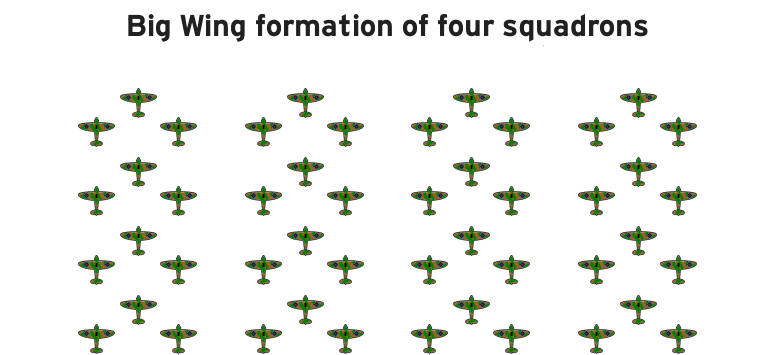
4 notes
·
View notes
Text
Looking back on a week in amazing Anglesey and wonderful wider North Wales
Over the past week another trip outside of England for me this year among mountains centred on a beautiful island has allowed us to have a special wild adventure. It was a week of splendour, spectacle and thrilling experiences.
Bird and mammal wise we saw some of the finest sights UK wildlife has to offer, from being ensconced in the spectacular tern and gull colony of Cemlyn, seeing our first Arctic Terns this year and marveling at the many neat Sandwich Tern, also seeing Common Tern and Black-headed Gull with views of chicks enjoyed to watching in aw in the evening sunlight a Red Squirrel feed in the magical Newborough Forest an astonishing sight to ensure I’ve seen these divine mammals in England, Scotland and Wales this year. The distinctive smell, consuming noise and fantastic sight of seabird colonies dominated the week, with charismatic and eyecatching Puffins, Guillemots, Razorbills, Kittiwakes, Fulmars, Shag and more enjoyed between two visits to the fabulous RSPB South Stack and a brilliant boat trip around Puffin Island. Days full of glee. Staggeringly intimate views of Grey Seal on the boat trip and fine evening views of Manx Shearwater gliding across the sea at Cemaes where we stayed and Llanbadrig and some seen at Cemlyn on the last morning were other moments of nautical wild bliss. It was phenomenal and valuable to get such splendid views of Black Guillemots again across the week, a favourite bird of mine we don’t get at home which I am having a top year for. Anglesey is synonymous with Choughs and at South Stack, the Range and on a journey at one point we have had some sensational times seeing these red and black wonders exceptionally well. Their sharp call and breathtaking appearance has left me spellbound and filled my heart with joy. We also saw some at the Great Orme on a wider North Wales part of the trip.
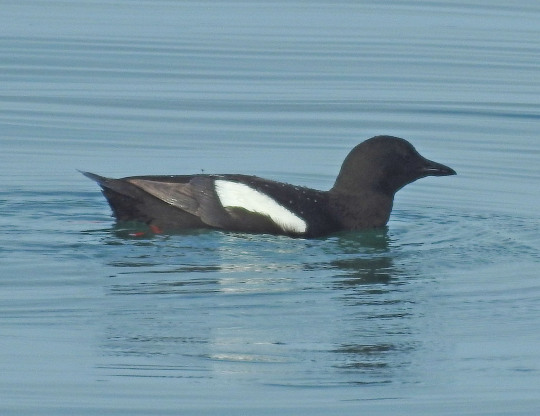
A Black Guillemot at Holyhead Fish Quay on Sunday evening

Chough at South Stack on Monday
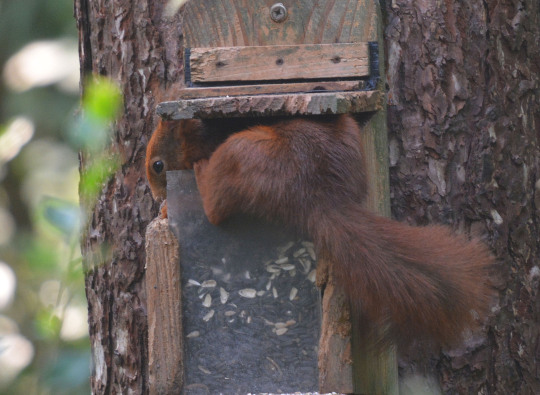
The Red Squirrel we saw at Newborough Forest
Adding further gloss and helping my bird year list become personally historic was my first sighting this year of a Little Ringed Plover on a wider jaunt to RSPB Conwy. Other standout birds of the trip included Shelduck, Oystercatcher, Red-breasted Merganser, Gannet including on Ynys Badrig, Herring Gull, House Martins, Swallow, Whitethroat, Bullfinch, Pied Wagtail, Wheatear, Rooks heard and seen well from the lovely cottage we stayed in, Raven, Jay and Buzzard. Crossing Eryri on Wednesday on the way back from Conwy seeing Grey Wagtail at Betws-y-Coed, Hen Harriers and Goosander and Common Sandpiper at Llyn Ogwen added some top species to the week.
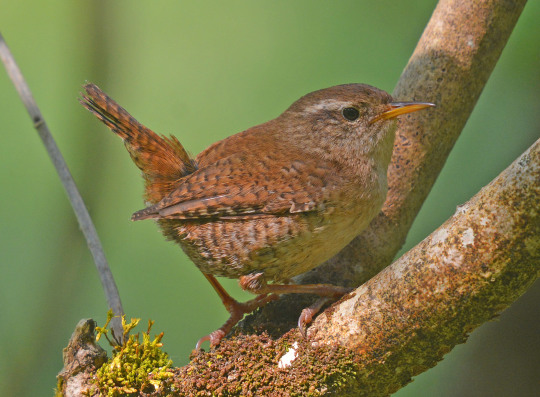
Wren at Nant-y-Pandy on Thursday which was a joy to see too.
In spring/summer holidays geared towards birds it’s always nice to see some insects during it and it occurred to me during the week we might be able to see Silver-studded Blues here, that we did at the Range by South Stack on Tuesday. Immersive moments watching this precious gem of a butterfly. In heatwave conditions as the week went on Ringlet, Dark Green Fritillary, Small Skipper and Common Grayling at the Great Orme probably of the sub species Hipparchia semele emerging early and unique to this site were ones we saw for the first time this year as I sailed into seeing summer butterfly species, with Meadow Brown, Common Blue, Large Skipper, Small Tortoiseshell and oh so many Red Admirals also seen. Hummingbird hawk-moth, Silver Y, my first Six-spot Burnets of the year seen well, Straw Dot, Brown-silver Line and Grass Veneers made it a marvellous moth week too.
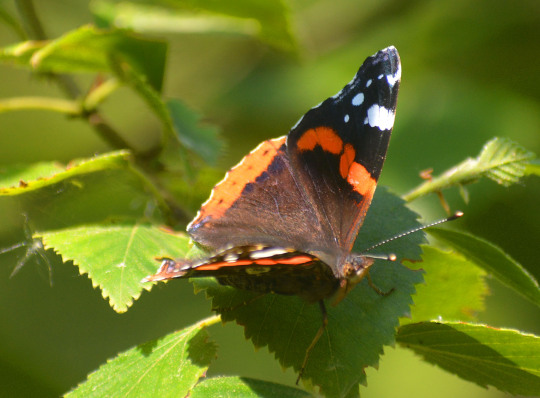
One of the Red Admirals seen this week at Newborough Forest
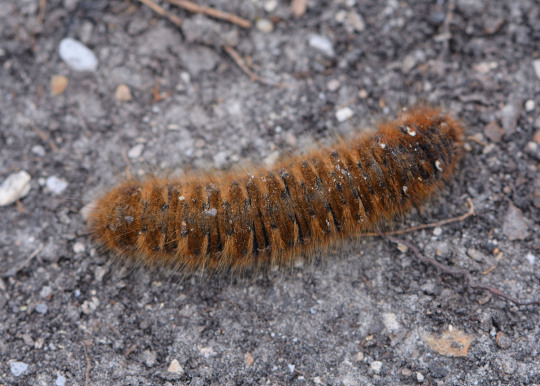
Caterpillars played their part too with a few seen, this of the Oak Eggar moth at South Stack.
As hoped we saw Four-spotted Chaser dragonflies, with a surprise Golden-ringed Dragonfly an exquisite moment in the trip at a stream at Nant-y-Pandy aka the Dingle and Southern Hawker also firsts for the year. Emperor, Broad-bodied Chaser as well as Blue-tailed, Common Blue and Azure Damselflies and Banded Demoiselle were pleasant to see too. It was also a top trip of beetles with many Swollen-thighed beetles and my first ever Chrysomela populi and Rose Chafer beetle seen.

Mating Azure Damselflies which was a strong memory of a hot and sunny time at Cors Ddyga on Thursday.

The Chrysomela populi, one of many we saw on a Newborough dune walk on Thursday.
It was a flower fest this week with massive species of my year seen such as my first alluring bee and pyramidal orchids of the year at RSPB Conwy and lots of sheep’s-bit. Marsh helleborine, early marsh orchid, purple sandwort, sea plantain and bright yellow-horned poppy were new flower species I was amazed to see. Thrift, sea and red campion, chamomile, wild carrot and cabbage, foxgloves, thyme, wall pennywort, bird’s-foot trefoil and rich English stonecrop seen consistently well were strong characteristic plants of the trip for me as many were when here two years ago. And on that note I could not forget the joy of seeing again at Valley Wetlands and Cors Ddyga RSPB reserves my star flower from 2021, excellent marsh cinquefoil.

One of the many RSPB Conwy bee orchids seen
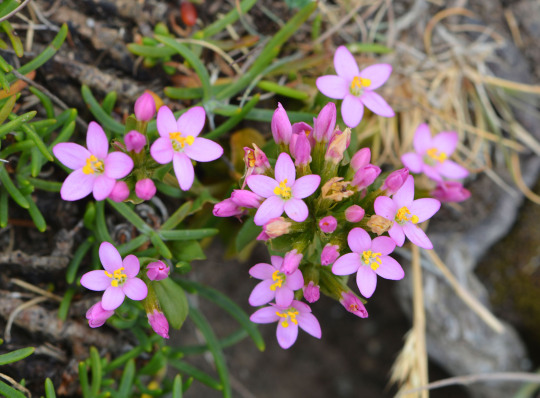
Centaury at South Stack, another key one this week.
The views were something else again; cliff, beach and dune coast, woodland, heath, meadow, lake and mountains. There were breathtaking moments observing stunning landscapes and being immersed in them on Friday riding the Great Orme cable cars at Llandudno and going three quarters of the way up Yr Wyddfa on the Snowdon Mountain Railway. I enjoyed stunning scenes of the sun going down over the water on evenings at Cemaes and Llanbadrig. It is such an aesthetically pleasing part of the world. What a week, so much covered and seen and so many glorious memories made. I love Anglesey and North Wales generally and I can’t wait to come back.

Looking across to South Stack from the Range on Tuesday
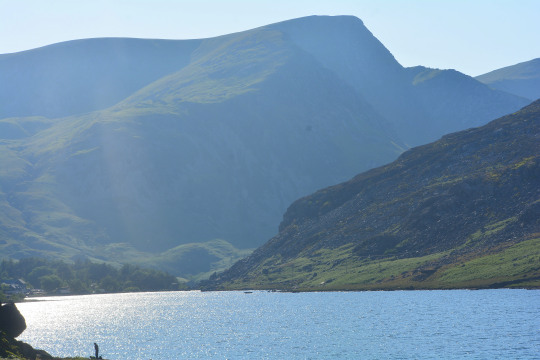
Llyn Ogwen on Wednesday
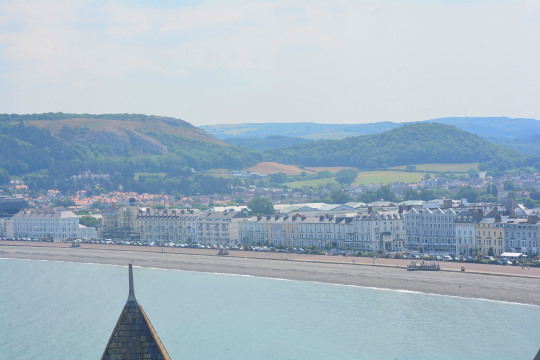
Llandudno on Friday

Grey Seal seen on the boat trip around Puffin Island on Tuesday.
#photography#birdwatching#birds#butterflies#uk#earth#nature#world#chough#black guillemot#grey seal#puffin#puffins#razorbill#guillemot#gannet#shag#red squirrel#bee orchid#little ringed plover#outdoors#sea#coast#island#anglesey#wales#north wales#holiday#june#2023
5 notes
·
View notes
Text
Daily Wrap Up August 13, 2022
Under the cut:
Two more ships carrying grain left from Ukraine's Black Sea ports on Saturday, Turkey's defence ministry said, bringing the total number of vessels to depart the country under a U.N.-brokered deal to 16
The two primary road bridges giving access to the pocket of Russian occupied territory on the west bank of the Dnipro in Kherson Oblast are now probably out of use for the purposes of substantial military resupply
Russian forces have taken full control of Pisky, a village on the outskirts in Ukraine’s Donetsk region
“Two more ships carrying grain left from Ukraine's Black Sea ports on Saturday, Turkey's defence ministry said, bringing the total number of vessels to depart the country under a U.N.-brokered deal to 16.
The Barbados-flagged Fulmar S left Ukraine's Chornomorsk port, carrying 12,000 tonnes of corn to Turkey's southern Iskenderun province, the ministry said. The Marshall Island-flagged Thoe departed from the same port and headed to Turkey's Tekirdag, carrying 3,000 tonnes of sunflower seeds.
Another ship was to depart from Turkey on Saturday to Ukraine to buy grains, the statement said.
Ukraine's infrastructure ministry said on Saturday that 16 ships carrying 450,000 tonnes of agriculture products had departed from Ukrainian sea ports since early August under the deal which ensured safe passage for vessels.
The agreement, signed by Ukraine, Russia, Turkey and the United Nations in July amid warnings of possible outbreaks of famine, allowed grain exports from Ukraine's Black Sea ports to resume after being stalled for five months due to the war.”-via Reuters
~
“The two primary road bridges giving access to the pocket of Russian occupied territory on the west bank of the Dnipro in Kherson Oblast are now probably out of use for the purposes of substantial military resupply, British military intelligence said on Saturday.
Even if Russia manages to make significant repairs to the bridges, they will remain a key vulnerability, the UK's Ministry of Defence said.
"Ground resupply for the several thousand Russian troops on the west bank is almost certainly reliant on just two pontoon ferry crossing points," the ministry said in an intelligence update.
With their supply chain constrained, the size of any stockpiles Russia has managed to establish on the west bank is likely to be a key factor in the force’s endurance, according to the update.“-via Reuters
~
“Russian forces have taken full control of Pisky, a village on the outskirts in Ukraine’s Donetsk region, Interfax cited the Russian defence ministry as saying on Saturday.
Russian and pro-Russian forces had reported that they had taken full control of Pisky more than a week ago.
The ministry also said that Russian forces had destroyed a US-supplied HIMARS rocket system near the eastern Ukrainian city of Kramatorsk and a depot with ammunition for the system, Interfax reported.”-via The Guardian
18 notes
·
View notes
Photo










More birds. First five are prions, tiny seeabirds that skim the waves and are very hard to identify. I think I identified three species on the trip and these ones are Slender-billed and Antarctic Prions. Pics of the Fairy Prion are pretty poor. Next is a Southern Fulmar and a Snowy Sheathbill. Then there are two Turkey Vultures - hunting on Saunders Island and hiding from the blizzard in Stanley. The last one is a Wandering Albatross, sadly wandering no more, in the Grytviken Museum. It looks big, but we saw some quite a bit bigger. Magnificent birds!
0 notes
Text
Saturday 9th January 2021
Birling Gap and The Seven Sisters, Sussex
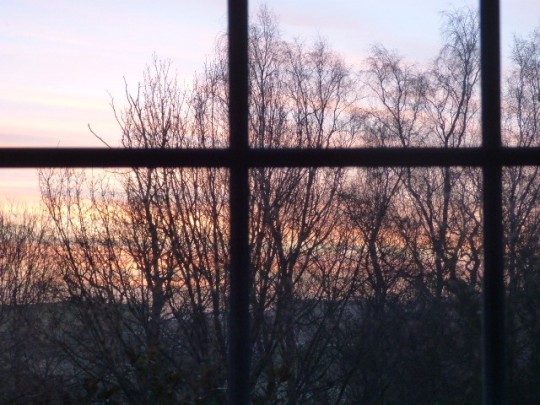
Brrr it’s really chilly. The big block of ice that Crow tipped out of the bird bath first thing, didn’t give any all day .

We have been getting a touch of frost in the mornings too and some foggy days.
Below is the view at the front towards the next village and where we look for the weather.
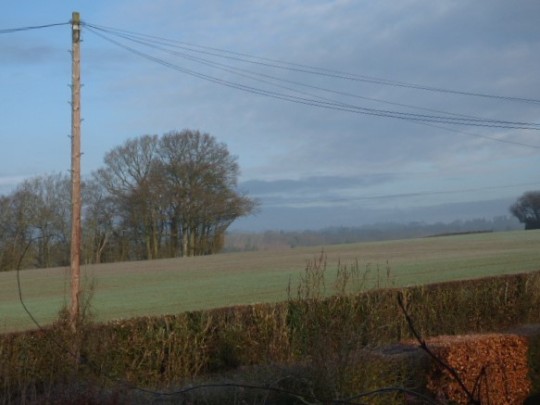

I��d used the bed in that room to plonk all the Christmas decorations on as I wanted to sort through them before making the boxes up, so I was there a while and looking at the mist descending.
You can see how it drops over the fields.

As we’re under the level of lockdown where you leave your home only if absolutely necessary, I’ve dug out some more of Ms NW tY’s photos so we can have another virtual trip out. This time it’s down at the south coast - Birling Gap and The Seven Sisters.
The Seven Sisters could be a country and western group, but in this case the name refers to a series of cliffs and because of coastal erosion it’s more like seven sisters and a cousin.
The sequence starts just east of Cuckmere Haven. all the cliffs and peaks between are named separately.
Listed below, the peaks are in italics.
Haven Brow
Short Bottom
Short Brow
Limekiln Bottom
Rough Brow
Rough Bottom
Brass Point
Gap Bottom
Flagstaff Point (continuing into Flagstaff Brow)
Flagstaff Bottom
Flat Hill
Flathill Bottom
Baily's Hill
Michel Dean[citation needed]
Went Hill Brow (grid reference TV549963).
Just east of the last peak is Birling Gap. Beyond, on the top of the next hill, is Belle Tout Lighthouse and beyond that Beachy Head. A lighthouse in the sea marks the latter headland.
Wikipedia
The origins of the names remains obscure.

Because the Seven Sisters area is free of development, the area is used for filming as a stand-in for the White Cliffs of Dover. The famous white cliffs are no longer as white as they sound and are greening with vegetation whereas the Seven Sisters remain pristine. The Seven Sisters are left to erode naturally by the waves and tides of the sea.
The area is designated and protected as a 'Heritage Coast' and is the finest example of unprotected chalk cliffs in Britain. From Seaford towards Eastbourne, including the famed Beachy Head, it’s around 21K.

photo credit: Ms NW tY
Seaford is an original Victorian seaside town with an unspoiled coastline, stunning scenery and is surrounded by the Sussex Downs Area of Outstanding Natural Beauty. Seaford Head Nature Reserve is a Site of Special Scientific Interest and it is from here that you get the classic images of the 'Seven Sisters', looking from Hope Gap across the Cuckmere Valley. Areas of chalk, grassland, salt marsh and shingle spit give a diversity of habitats for wildlife, especially birds.

photo credit: Ms NW tY

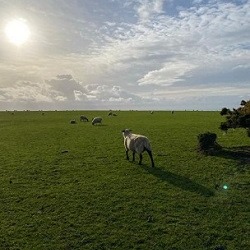
photo credit: Ms MW tY
There used to be a sheep centre and you could go down there for lambing, which was lovely, but it’s closed now
Seven Sisters Lambing

photo credit: National Trust
Bird watching
With a wide variety of different habitats packed into this special 280 hectare site, there are some great year round birding opportunities, weather and visitor pressures permitting!!
Early Spring sees the gradual departure of winter “whistling” wigeon, teal, little grebe, curlew, geese, oystercatcher, a mixed bag of gulls and regular kingfisher sightings as they head away to breed.
Their departure heralds the onset of the migrating season. Watch the wetlands for more unusual waders (such as black-tailed godwits) alongside the more familiar redshank, dunlin and ringed plover. The scrubby bushes along the valley, stunted by the salt spray and harsh onshore winds, are alive with warblers and linnets.
Swallows, martins and swifts means late spring has arrived and the Park settles down to summer residents of heron, little egret, shelduck, mallard, Canada geese, redshank and dunlin on the wetlands.
Fulmars, kittiwakes and jackdaws nest precariously on the cliffs, and amongst the Downland; please keep those dogs (and children!) under control to enable the ground nesting skylark, meadow pipits, and wheatear to breed.
The bushes throng with the song of robin, blackbird, various tits and dunnock, and the more unusual whitethroats. Along the valley yellowhammers sing ‘little bit of bread and cheeeeeeeeese’, and several pairs of stonechat parade on bramble perches. Watch out for raptors including sparrowhawks and hovering kestrels.
Late summer migration almost mirrors the spring version – though the birds often stay longer now the haste to breed is over and there is a chance to feed up on the abundant fruits and berries.
Maps and a bird list available in the Visitor Centre.

Male Black Redstart. Photo credit National Trust
I’d not come across Black Redstart before doing a bit of research for this Blog, what a lovely little bird. I found a couple of other Blogs which have more information and photos and are well worth a read
Martin’s Birding
and
Wild Hastings
♦ All the information today is from a combination of the National Trust, the Seven Sisters org and Visit Southern England.
What I Learned Today
The black redstart is a small robin-sized bird that has adapted to live at the heart of industrial and urban centres. Its name comes from the plumage of the male, which is grey-black in colour with a red tail.
With fewer than 100 breeding pairs in the UK, the black redstart is on the Red List of Birds of Conservation Concern. Is is also listed as a Schedule 1 species on The Wildlife and Countryside Act.
What they eat: Insects, spiders, worms, berries and seeds.
Measurements: Length:14.5cm Wingspan:23-26cm Weight:14-20g
Population: UK breeding:19-44 pairs UK wintering:400 birds
Notes from the Kitchen:
Today’s breakfast was omelettes. Crow had some chestnut mushrooms in his and I had cheese and tomato. I souffléd them by separating the eggs and whisking up the yolks and whites independently before combining gently to keep as much
2 notes
·
View notes
Text
Megapaloelodus

By Scott Reid
Etymology: Great Ancient Marsh-Dweller
First Described By: Miller, 1944
Classification: Dinosauromorpha, Dinosauriformes, Dracohors, Dinosauria, Saurischia, Eusaurischia, Theropoda, Neotheropoda, Averostra, Tetanurae, Orionides, Avetheropoda, Coelurosauria, Tyrannoraptora, Maniraptoromorpha, Maniraptoriformes, Maniraptora, Pennaraptora, Paraves, Eumaniraptora, Averaptora, Avialae, Euavialae, Avebrevicauda, Pygostaylia, Ornithothoraces, Euornithes, Ornithuromorpha, Ornithurae, Neornithes, Neognathae, Neoaves, Aequorlitornithes, Mirandornithes, Phoenicopteriformes, Palaelodidae
Referred Species: M. connectens, M. peiranoi, M. goliath, M. opsigonus
Status: Extinct
Time and Place: Between 20 and 6.8 million years ago, from the Burdigalian to the Tortonian of the Miocene


Megapaloelodus is known from a variety of environments: the Ituzaingo Formation, the Graupensandrinne, the Almejas Formatio, the Temblor Formation, the Barstow Formation, the Batesland Formation, the Juntura Formation, and the Grillental Site; ranging across Argentina, Germany, Mexico, the USA, and Namibia.

Physical Description: Do you ever wonder what a Flamingo would look like if it tried to swim? Well, here is your answer: the Giant Swimming Flamingo, Megapaloelodus. The swimming-flamingos were a ridiculous group of dinosaurs from the Cenozoic that combined the swimming of the grebes with the weird wading of their close relatives, the flamingos - and these things were common and they were huge. Megapaloelodus was a prime example of that, and it was extremely widespread. Like other members of its group, it lacked the weird filter-feeding bill of modern flamingos, but also the more narrow beak of modern grebes - instead, it had a fairly generalistic, middle-of the road beak, triangular and sharp. It had long legs, but not quite as long as the living flamingos, and a long neck and squat body - also like living flamingos. But it retained ankles that would have allowed Megapaloelodus to stand upright for a long period of time, but it was also able to wade in deep water and swim around like a wading duck. Megapaloelodus was, in a lot of ways, also convergent with modern Flamingos - able to properly wade in the water without having to tread it like living ducks do. The average species of this creature was about 1.5 meters tall, though at least one species (that may or may not actually belong to the genus) got as big as 1.8 meters tall.
Diet: Megapaloelodus would have fed on aquatic invertebrates and fish.

By Ripley Cook
Behavior: As a swimming flamingo, Megapaloelodus would have divided its time somewhat between wading in water and standing on the bottom of the lakes and coastlines it called home, searching for food wherever it could - and swimming out into deeper waters to find more food to eat. Not a filter-feeder, it would have probably had to scoop up food with its beak, gathering as many shelly creatures and fish as it could in order to feed upon it. Since these dinosaurs were so common, it seems likely they lived in large flocks like living Flamingos do, associating with each other in order to stay safe in the face of large predatory mammals and birds, and also to search for new sources of food! As a dinosaur, it most likely took care of its young, though we don’t have fossil evidence of its reproductive behaviors.
Ecosystem: Megapaloelodus was found all over the world during its time, usually associated with bodies of water, such as lakes, estruary bays, and coastlines. In fact, Megapaloelodus especially favored coastlines, indicating that it probably did feed at least somewhat on similar things as living flamingos - salt or brachish-water creatures. Whether or not it would have been pink like living flamingos seems somewhat unlikely. In these environments, Megapaloelodus would have interacted with a wide variety of late-Cenozoic creatures - whales that were almost, but not quite, like living ones; a wide variety of sharks big and small; but also more inland creatures where Megapaloelodus would have spent a considerable amount of time in more lake and swampy environments, where it would interact with rabbits, rodents, ruminants, horses, and bear-dogs. As for other dinosaurs, Megapaloelodus lived in the same place as many - more than I am able to list here - but notable neighbors include the flightless auk Mancalla, the pseudotoothed bird Osteodontornis, the pheasant Miortyx, a variety of ducks and swans, the hoatzin Namibiavis, and potential ostriches. In short - where you looked, especially in North America and on the coasts, you probably could find a swimming-flamingo, whether Megapaloelodus or otherwise.

By José Carlos Cortés
Other: Megapalelodus is a fascinating species due to the fact that it is one of the swimming flamingos… except it could actually properly wade like a true flamingo! This showcases that the flamingo-lifestyle evolved multiple times in the grebe-flamingo group. Now we just need to find some Wading Grebes…
Species Differences: M. connectens was the original species of this genus, known from the Miocene of North America; it is possible that it is actually two species, including the often-ignored M. peiranoi, given the range of time and places they lived in, but they were nearly identical and that is hotly disputed. M. opsigonus is also known from later in time, and it was somewhat larger than the earlier M. connectens. The real controversial species is M. goliath - the biggest of all of these, it was much more similar to Palaelodus than to Megapaloelodus and thus might be a part of that genus instead.
~ By Meig Dickson
Sources under the Cut
Barnes, L. G. 1973. Praekogia cedrosensis, a new genus and species of fossil pygymy sperm whale from Isla Cedros Baja California, Mexico. Contributions in Science, Natural History Museum of Los Angeles County 247:1-20
Barnes, L. G. 1984. Fossil odontocetes (Mammalia: Cetacea) from the Almejas Formation, Isla Cedros, Mexico. PaleoBios 42:1-46
Barnes, L. G. 1988. A new fossil pinniped (Mammalia: Otariidae) from the middle Miocene Sharktooth Hill Bonebed, California. Contributions in Science 396:1-11
Barnes, L. G. 1991. The fossil marine vertebrate fauna of the latest Miocene Almejas Formation, Isla Cedros, Baja California, Mexico. Memorias Universidad Autonoma de Baja California Sur: Primera Reunion Internacional Sobre Geologia de la Peninsula de Baja California 147-166
Brodkorb, P. 1961. Birds from the Pliocene of Juntera, Oregon. Quarterly Journal of the Florida Academy of Sciences 24(3):169-184
Carroll, R. L. 1988. Vertebrate Paleontology and Evolution 1-698
Cione, A. L., M. M. Azpelicueta, M. Bond, A. A. Carlini, J. R. Casciotta, M. A. Cozzuol, M. Fuente, Z. Gasparini, F. J. Goin, J. Noriega, G. J. Scillato-Yane, L. Soibelzon, E. P. Tonni, D. Verzi, and M. G. Vucetich. 2000. Miocene vertebrates from Entre Rios province, eastern Argentina. Serie Correlacion Geologica 14:191-23
Harksen, J. C., and J. R. Macdonald. 1967. Miocene Batesland Formation named in southwestern South Dakota. South Dakota Geological Survey Report of Investigations 96:1-10
Howard, H. 1955. A new wading bird from the Eocene of Patagonia. American Museum Novitates 1710:1-25
Howard, H. 1984. Additional avian records from the Miocene of Kern County, California with the description of a new species of fulmar (Aves: Procellariidae). Bulletin of the Southern California Academy of Sciences 83(2):84-89
Kloess, P. A., and J. F. Parham. 2017. A specimen-based approach to reconstructing the late Neogene seabird communities of California. Palaeogeography, Palaeoclimatology, Palaeoecology 468:473-484
Mayr, G. 2017. Avian Evolution: The Fossil Record of Birds and its Paleobiological Significance. Topics in Paleobiology, Wiley Blackwell. West Sussex.
Miller, Alden H. (1944). "An avifauna from the Lower Miocene of South Dakota". University of California Publications, Bulletin of the Department of Geological Sciences. 27: 85–100.
Miller, Loye H. (1950). "A Miocene Flamingo from California". Condor. 52 (2): 69–73.
Miller, Loye H. (1954). "The Avifauna of the Barstow Miocene of California". Condor. 54 (5): 296–301
Sach, V. J., and E. P. J. Heizmann. 2001. Stratigraphy and mammal faunas of the Brackwassermolasse in the surroundings of Ulm (Southwest Germany). Stuttgarter Beiträge zur Naturkunde Serie B (Geologie und Paläontologie) 310:1-95
Shotwell, J. A., and D. E. Russell. 1963. Mammalian fauna of the Upper Juntura formation, the Black Butte local fauna. Transactions of the American Philosophical Society 53(1):42-69
Wetmore, A. 1960. A classification for the birds of the world. Smithsonian Miscellaneous Collections 139(11):1-37
#Megapaloelodus#Flamingo#Swimming Flamingo#Dinosaur#Grebe#Bird#Birds#Dinosaurs#Aequorlitornithian#Prehistoric Life#Paleontology#Prehistory#Palaeoblr#Birblr#Factfile#Neogene#Water Wednesday#Africa#Eurasia#South America#North America#Piscivore#Megapaloelodus connectens#Megapaloelodus peiranoi#Megapaloelodus opsigonus#Megapaloelodus goliath#biology#a dinosaur a day#a-dinosaur-a-day#dinosaur of the day
183 notes
·
View notes
Photo

September 1, 2019 - Fulmar Prion (Pachyptila crassirostris)
Breeding on several islands around New Zealand, including Auckland, Chatham, Snares, and Bounty Islands, and in the south Indian Ocean on Heard and McDonald Islands, these small petrels spend the rest of the year in the southern Pacific and Indian Oceans. Their diet includes a wide variety of marine invertebrates, such as crustaceans, barnacles, squid, and mollusks, as well as small fish. They pick their prey from the water’s surface or capture it in short dives. Breeding in dense or loose colonies, sometimes near other seabirds such as albatrosses, they nest in crevices, rock piles, scree slopes, and caves. Females lay a single egg.
76 notes
·
View notes
Photo






A sea-stack at Sturge Island giving us the finger, more of Sturge Island - and a closer shot showing some of the several ‘snow showers’, like waterfalls, below small seemingly permanent avalanches. More wildlife - a Weddell Seal and one of many thousands of Southern Fulmars. Iceberg ahoy - a slightly wider shot would have shown the narrow passage to the the right of this one with another big berg and the waves roaring through. That’s where we went with with only metres to spare. We certainly lived in exciting times! Yay(!!!!!) for Russian seamen!
1 note
·
View note
Text
Day 7 - Colonsay
Distance – the entire length of Colonsay (about 7 miles). Height gained – not much.
Adversity – 2, but only because there was a cold wind at breakfast. Other than that it has been a beautiful, easy day.
Bird of the day – the auks have it.
Serenaded by drumming snipe overnight, but no corncrakes to keep them company.
Woke to broken cloud and a moderate south westerly which, as it comes in off the Atlantic, was cold. So full waterproofs whilst we ate our porridge and drunk our coffee.
Then a walk around the south eastern headland of Colonsay. Up over a small hill to begin with copious sundew, heath spotted orchid and marsh orchid and small pools and a lochan with bog bean and white water lily. Then down to the coast and an idyllic series of sandy coves with crystal clear water.
Found the choughs heard yesterday, nesting in a cave above the dunes on the southern end.
Back to the tents and bikes, broke camp and cycled to the hotel for lunch. Mackerel pâté for me, mussels for H. Delicious, but service chaotic.
Then down to the ferry terminal to refill our water bladders and a gentle cycle up the west coast of Colonsay to Kiloran bay. Pretty road with other pretty beaches, but Kiloran beach stunningly beautiful under a clear blue sky. And the perfect tent pitch (see previous criteria) with views across to Mull and Ben More.
Made camp and had tea and ginger cake. Then changed into Speedo’s and headed for the beach. Water freezing, but managed 20 m before decided it was enough to be able claim I had swum.
Then a walk along the mile of golden sand and back.
After supper (dried pasta as per last night) walked to Dun Tealtaig with H & S hoping to see some auks flying past. Instead found a brilliant nesting colony of guillimots and razorbills together with shags, fulmars and kittiwakes. Very close views in perfect light. On the way saw the cruise ship that had passed earlier steaming back east only to see a helicopter arrive and clearly take someone off and the cruise ship then turn round and head back out to sea.
Arrive back at the tents to find a man standing in the sea in his speedos playing the bagpipes to a group of about 20 people stood on the beach – it’s all happening here.
Have been joined at our camp spot by a lone girl on a bike, who presumably came in on this evenings ferry. Think she might have been a bit surprised to find the prime real estate already occupied by our two tents.
Another great day and the forecast remains good.
1 note
·
View note
Text
Excerpts from On Rona, by Kathleen Jamie
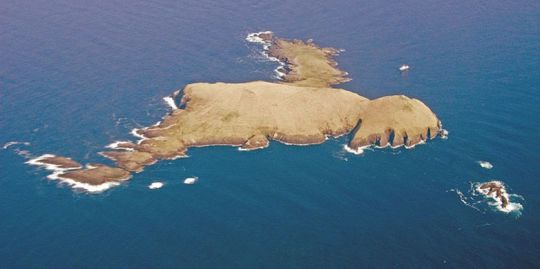
‘The island is only a mile and a half long. It has one fertile hill, and two flat near-barren peninsulas, one pointing north, one southwest, like two mismatching wings. There are no beaches, all is cliff, swooping now high, now low, and cut with many geos. The sea prowled into every geo; by night its sound seemed muted, though now and then the breeze brought whoops of seal-song. Clouds were gathering, but that was good, Stuart said: the darker, the better.

We walked westward up a slight rise, which at its crest gave views down a long slope to the ragged peninsula called Sceapull, which soon surrendered to the waves. A dusty, antique sort of light lay over the islands; the sea was the colour of tarnished silver. The path led across a hillside, then through a gap in an earthen dyke. At once, within the dyke, the land began to rise and fall in ridges, like those of a vast scallop shell, waist-high ridges between shallow-filled troughs, all with a pelt of long grass that shivered in the wind. The ridges curved downhill toward the sea. Hundreds of years ago oats of barley would have been raised on them, but now, long overgrown, they had become sculptural, land art.
We passed through that strange estate, then arrived at the shell of St Ronan’s chapel. Just four stone walls, all speckled with lichen, a low doorway, no roof at all. It faced the southern sea, and between the chapel and the cliffs a quarter-mile away were ovals and pockets of darkness, half dug into the eath, and bound by overgrown turf walls - all that remained of the village. Beyond that, beat of the waves. This was what we’d come for, something faraway and special, so we settled ourselves against the chapel wall to wait. [...]

You have to go a long way to find a breeding colony of Leach’s fork-tailed petrels; to a handful of the farthermost islands, St Kilda, the Flannans, and here, Rona, where on summer nights they make the quick dash ashore. Mate calls to mate, dit-dit diidle-dit!, rival pursues rival, one partner creeps back into his burrow-nest, allowing the other to be off on her small black wings, far out to sea.
The call, to our human ears, sounded like laughter. At the darkest hour, the walls, like a hive, were busy with birds. They’re small as swifts, but their challenge isn’t the ocean storms, it’s the short race ashore. Great skuas - bonxies - prey on them, god knows how, hence their dash by moonlight - except they prefer no moon. They prefer the darkest of summer nights. [...]

Nothing is known of St Ronan but his name, which, oddly, means ‘little seal’ - as if he’d been a Rona selkie who’d swopped his sealskin for the habit of a monk. Doubtless he was one of the early Scots-Irish monks, who sailed from his monastery to seek ‘a desert place in the sea’, where he could live a life of austerity and prayer. Hundreds of years later, the people built the chapel in his name, and buried their dead beside it. Now those people are gone, too, and their graveyard is a poignant place. [...]
St Ronan rode to Rona on the back of a seamonster, so the legend says. Monster or boat, he’d have jumped ashore giving prayers of thanks, sometime in the eighth century. [...]
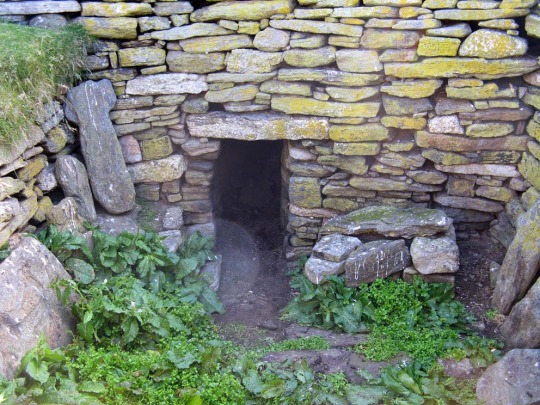
But we know what the saint sought, because on faraway Rona there survives something unique. A tiny building. To enter, you must first enter the chapel. Then, low on the eastern gable is another doorway, just a square of darkness with a lintel of white quartz, as though it were Neolithic. You have to crawl, but once inside you can stand freely. At first it seems wholly dark, and it smells of damp earth, but as your eyes adjust, stars of daylight begin to spangle here and there overhead, where, over the many centuries, the stones have slipped a little - so after a while it’s like being in a wild planetarium.
Darkness, eath - and a sudden quiet; no wind or surf - you find yourself in a place from which all the distracting world is banned. Then you see the stonework. The little oratory is beautifully made, and has stood for 1200 years. A low stone altar stands against the east wall. So there is one thing we know of the saint - he had a feel for stone; strong hands. Or someone did. Having sailed here and claimed this island of sea-light and sky and seals and crying birds, he built himself a world-denying cell.

[...] I crept into the oratory, and waited till my eyes adjusted to the low light. I went warily, because a fulmar had made her nest in a corner; too close and she’d spit. A fulmar guarded the saint’s cell, and it was strange to think there were Leach’s petrels secreted in the walls. Seabirds, named for St Peter, who walked on water, had colonised a cell built by a saint named for a seal.
I crept in just to wonder what he did in there, Ronan; to imagine him right there, in front of the altar, wrapped in darkness, rapt in prayer, closed off from the sensory world, the better to connect with... what?’

All photos by Marc Calhoun, except for the birds eye view - found on flickr.
#Kathleen Jamie#Sightlines#Nature#Rona#North Rona#Observation#St Ronan#History#Bonxie#Great Skua#Leach's Petrel
1 note
·
View note
Link
Excerpt:
Federal wildlife officials are documenting a die-off of Alaska seabirds stretching from north of the Bering Strait to the Gulf of Alaska that may be connected to a trend of warming ocean water.
Carcasses examined so far have shown no indication of disease, and tests are pending for harmful algal toxins. Seabirds have been found emaciated and starved, and changed ocean conditions may have affected prey.
“As in the past, these die-offs have been associated with unusually warm water conditions,” said Katherine Kuletz, a U.S. Fish and Wildlife Service seabird biologist. “That’s only increased in the last few years.”
The Fish and Wildlife Service and the National Park Service in May received reports of dead and dying seabirds, or birds acting abnormally, north and south of the Bering Strait. Most were common or thick-billed murres.
Officials recorded deaths of forktail storm petrels, fulmars, shearwaters, kittiwakes, auklets and puffins.
Bird die-offs usually are localized, Kuletz said. The 2018 numbers have not matched a die-off in late 2015 and 2016, when hundreds of thousands of common murres died.“I think what’s different is that the numbers, even though they’re in the dozens or hundreds, they’re widely dispersed and very highly concentrated in the north Bering Sea and the southern Chukchi Sea, which is unusual,” Kuletz said. “Most of our large die-offs have occurred in the southern Bering Sea or the Gulf of Alaska.”
Common murres, known elsewhere as common guillemots, are an indicator of the health of an ecosystem. Plentiful in Alaska, murres eat finger-length forage fish such as capelin and juvenile pollock. They have a high metabolism rate and must eat prey matching 10 to 30 percent of their body daily.
2 notes
·
View notes
Photo










20th June 2022: Bempton Cliffs post one of two-The birds
I had a fantastic six hours plus at RSPB Bempton Cliffs today, the main point of this holiday. It was a sensational day of wildlife watching and for photos in a beautiful place in glorious sunlight what brilliant weather to have for this headline trip of the holiday on our first weekday away. I split the posts with so much seen and many photos taken today, in this post I talk about the birds we saw today and the next one has descriptions of the other wildlife and flora we saw and landscape photos of the day. My full wildlife sightings summary of today is in my next post too.
It was of course all about the seabirds today especially a Bempton specialty the Gannet. It was a true honour to watch hundreds of these gigantic birds of all age ranges swirling around the cliffs, on the cliffs and flying right over. We saw these elegant birds beak rubbing and it was great to hear them so well and getting to see them incredibly intimately as they dashed over. Seeing them with grass and seaweed in their bills was phenomenal too. Bempton Cliffs really is the best place I’ve ever watched these birds I have loved since my early birdwatching days in terms of seeing them so closely it’s a great chance to look at a colony. Eating lunch on a bench whilst Gannets flew over was bliss. I took the third and final two pictures in this photoset among others of these.
Kittiwakes a true seagull flew like mythical beings all day and it was good to see them on the cliffs and scattered on a low rock beautifully, hearing their iconic call was the soundtrack to the day as well which was amazing. An honour to see these too, and watching Fulmars swerve and glide on the wind like (non-bird variety) kites was a mesmerizing sight. It was an auk fest too with stunning Guillemots seen well, lots of Razorbills both on the cliff and flying in looking fairly otherworldly what a year I have had for them from the off and of course there were Puffins the bird on the shirt I wore today and a species I love very much. Seeing their exotic beaks and feet again this year after seeing them so well on and around Skomer Island in April made me feel truly spoiled. I took the fourth and fifth pictures in this photoset of Guillemots, sixth of a Razorbill and seventh of Puffins. I enjoyed seeing a lot of these birds with one another on the cliffs a key part of this amazing experience today and as I have said before it sets Bempton apart from me the fact you can see a lot of these glorious seabirds above you in the air I had that with four of them at points today a great perspective to feel immersed in seeing them in.
I felt incredibly lucky that I was here looking at and adoring these birds to the backdrop of the devastating current conditions with avian influenza devastating seabird populations across the country which it feels so sad and I feel so helpless to it and obviously many other birds are impacted, so I felt I needed to keep that in mind today.
For the last three years a rare Black-browed Albatross has been coming to Bempton. He had gone wandering before we got here flying somewhere else it is believed in search of a mate not easy for a bird that is in the wrong hemisphere and we wondered whether we might not catch him. But around half way through the time here today our lovely tea and cake we enjoyed at the great cafe’ here was interrupted as RSPB staff gave word that the albatross was back flying along the cliffs they had seen it. We rushed back down to the viewing platforms to the right from the visitor centre looking over the rock and area it frequents and got into the right place at the right time to see this exotic and enormous bird flying out over the water twice before settling down on the cliff out of view. What an amazing and dream like moment to see this incredible species and family group iconic of the Southern Hemisphere. I feel so wonderful that we saw this famous bird and so lucky, what a stunning and magic few minutes.
It’s my milestone 280th bird species I’ve seen in my life and milestone 180th bird of 2022. Repeating a trick I did in 2017 of my life and year list total being 100 apart before and after a sighting. It’s another massive bird to be a round figure on my year list this year. I am entirely UK based for birdwatching at this stage in my life, I hope I might get a chance to watch wildlife abroad some time in my life, an albatross is something I might hope to see on one of these as a massive seabirder and seabirds the animals that make my heart skip most right up there with the main animals I loved as a kid penguins, so whilst I’ve seen and adore the Fulmar it’s relative one of my favourite birds seeing something called an albatross is bucket list stuff and seeing it in the UK England at that is sensational.
Leading a top stock of other birds seen today were Tree Sparrows, it was a pure joy to see these well marked and exquisitely coloured birds so many times again today, I got some pleasing intimate views of them. I loved seeing them both near the visitor centre and around the cliffs and also like I saw with a Linnet today one on a cliff and going into a hole in it which was fascinating. I took the first two pictures in this photoset of them.
Its easy to draw comparisons with Skomer this year for us as another big seabird day in a holiday today and a big moment of my Skomer on the first day we went on the island this year was of course the unexpected bird of prey when an Osprey flew over. And I had an unexpected bird of prey moment today when my Mum spotted yet another Barn Owl lately and whilst away and I saw it this time flying over the fields. An exceptional moment with another bird I’ve had a top year for.
Also of note was as well as the charming coloured adults zipping through the air a Swallow’s nest on the visitor centre with some adorable chicks in there which was brilliant to see. It was interesting in the evening when we were just leaving as the nest is the other side of the shutters, but there is a slight gap at the top which the adults get through and I saw one do it which was fascinating. What a smart place to nest as its well covered out of hours and the RSPB staff do look after them in the day time. A Corn Bunting was another wonderful farmland bird to see today and quite a rare species like the Tree Sparrow with Skylark in one of my best years for them seen and heard well today. Swifts were another highlight flying around again. I took the eighth picture in this photoset of some pigeons on the cliffs a nice and regular sight again today.
#photography#birdwatching#corn bunting#tree sparrow#skylark#barn owl#guillemot#razorbill#puffin#kittiwake#fulmar#gannet#black-browed albatross#amazing#birds#nature#uk#world#happy#yorkshire#coast#sea#europe#farmland#cliffs#30 days wild#monday motivation#holiday#sunny#sun
7 notes
·
View notes
Text
Days 12 to 14 - mainly at sea
Day 12, Tuesday, 27 December
After an early breakfast, we had another historical lecture from Nina and it was highly entertaining again, maybe not as riotous this time, but we still had plenty of belly-laughs. It was the story of Shackleton Part 1 (and Part 2a because we had a bit of extra time for her to set the scene for where we would be (quite literally) at the end of her session). We had been in open ocean for over 12 hours, running to Point Wild on Elephant Island – just where Shackleton and Wild reached as we were having lunch according to Nina – but we have to wait unto tomorrow to find out what happened to them when they caught up with us. I can hardly wait.
Because we both have bad colds that we don’t want to pass on to others, we have been trying to eat in the starboard corridor leading into the dining area where they have four tables for two rather than the fours, sixes, and eights in the main area. They are great tables too because each of the tables along there has one of the best viewing windows anywhere on the ship. Viewing areas are very poor on both of Aurora’s ships but they have four wide floor-to-ceiling windows and that is where our targeted cross-contamination-free tables are. Toward the end of lunch, quite suddenly, there were lots of seabirds flying past and we started seeing whale blows not far from the ship. I went up to the Observation Deck (where you can see out both sides) and saw at least a dozen whales (you don’t see much of the whale, mainly just the blow) and hundreds of seabirds. There were lots of Cape Petrels and Southern Fulmars, at least a dozen Black-browed Albatrosses, a Wandering Albatross, some Grey-headed Albatrosses, both North and South Giant Petrels, an Antarctic Petrel and several Sooty Shearwaters. I had some fun trying to photograph them, but it was very cold and windy so I had to retreat inside fairly soon. Late in the day, we came across an even bigger concentration of birds, including lots of penguins, and over twenty whales. The ship followed them for a while, but we have to get to South Georgia on schedule, so we turned around and ‘set sail’ for more northerly locales.
Just before we saw this big pod of whales, there had been a zodiac cruise around Point Wild for those who wanted it. It was only for those more agile expeditioners because there was a 2-metre swell and getting on and off the zodiacs was a challenge. It was snowing and we chose not to go out, particularly given our health issues. Wild by name and wild by nature. People enjoyed it, but not something we would cherish given the conditions – and our conditions. It was quite fearsome.

Point Wild: It doesn’t look so wild ut it really was fearsome.
The recap was a bit odd before dinner. We had two mini-presentations, both pretty flippant and insubstantial. The first was a forgettable blurb about whales and the second could have been good because the few slides were useful, but the presenter raced through it with just the odd throwaway line. It could have been made into a proper lecture/information session but both were essentially time-wasters to pad out the Recap. I asked if the better of the two could be redone as a lecture and although I was given a very encouraging response, it never happened.
Day 13, Wednesday, 28 December
We were at sea all day – and the same again tomorrow as we traversed the South Scotia Sea, heading for South Georgia, a British Colony and Protectorate.
We sat at our favourite table for breakfast and watched a bit of snow falling outside the window. And we sat there again for lunch and it was almost a snowstorm outside, but there had been very little in between. There is almost always a lonely errant snowflake blowing around when we look outside, but it was full-fledged flurries at lunchtime.
We had another great lecture from Ian McCarthy in the morning, mainly about filming wildlife in South Georgia for some of the Attenborough series. He certainly has had an exciting life but he is now retired and writing a book about it so we ‘pre-ordered’ a copy of it when it is finished. He hopes it will be published within a year. He is a very interesting character, pretty self-effacing, and a very gentle man. He is not afraid to let his softer side show and I like him a lot.
We spent some time sailing along a very large iceberg and then the ship turned and sailed back a league or two so the people in lockdown on the starboard side could see it too. It is part of what is believed to be the biggest iceberg in history. It was named A76 (how romantic!) and was about 170 by 25 kilometres when it broke off the Ronne-Filchner Iceshelf in the Weddell Sea in 2021 but it subsequently broke into three gigantic pieces all slowly drifting north. The one we passed is called A76a – b and c are still out there. Its sides are pretty much vertical with about 50 metres above sea level which suggests it could be up to 450 metres deep underwater – that’s a lot of Scotches on the Rocks.


A short stretch of A76a and a direct view of its 50-metre high side. (The staff used a rangefinder and some clever trigonometry to measure it at 49.3 metres +/- the swell.)
Shackleton finally got to South Georgia, and all his men were rescued, in a most exciting retelling of the story by our wonderful narrator Nina this afternoon. She has a fantastic way of engaging with you so you almost feel as if you are one of the characters in the story. We were almost in tears at times and there was an almost audible sigh of relief when they finally reached safety – even though we all knew the story before she started it. I reckon she could get a job as a storyteller anywhere – simply wonderful.
At lunch, we watched a big rainstorm a few kilometres/nautical miles/leagues away. It was very dense and looked heavy in a concentrated area for half an hour or so, but gradually spread more widely and seemed to travel along with us for at least an hour. The rest of the area seemed to be completely rain-free. Late in the afternoon, Ian did another eBird Survey and a few of us contributed to that and then it was a Recap/Precap and dinner.
After dinner, there was a Trivia Contest in the Lecture Theatre, but we were pretty tired so retired to our cabin and did not participate in that one. I think quite a few other passengers also felt too tired for Russell’s exuberance and gave it a miss too. Russell has the smarts and was probably a good quizmaster, but he is quite over the top, loud and boisterous, and often quite inappropriately flippant. He could be a valuable contributor if only he calmed down a few thousand percent.
Day 14, Thursday, 29 December
At sea again all day but the sea remained amazingly calm, so the crossing continued to be pleasant. (I haven’t needed any seasickness pills at all so far, although I used a patch unnecessarily on our first night in the peaceful Drake Passage.) And we never got bored – as if we could! We had a compulsory biodiversity briefing in the morning and we were required to re-check and re-vacuum all our (already-checked and vacuumed) outer clothes to mitigate the risk of any contamination when we reached South Georgia.
There was an interesting lecture about South Georgia during the morning, including a film made by the Tourism Trust. It is certainly an awesome place but with a lot of mostly dark history as well.
After lunch, I was on the back deck photographing some Giant Petrels with the ship rocking and rolling a bit – and I got drenched! As the ship rolled a little, maybe 50 litres of warm water from the jacuzzi on the deck above me overflowed and dumped straight down on me and particularly my camera and binoculars. I went straight back to the cabin and changed into a completely fresh set of clothes and then tried to get as much water as possible out of my camera. It was mainly in the barrel of my zoom lens and I was able to get quite a bit out so I hope there is no permanent damage. It doesn’t zoom as easily and smoothly as it used to so I may need to have it checked when I get home. There also seems to be a few dust specks inside my binoculars (not from my drenching) so I may need to have them checked too.
During the afternoon, we did a bit more Citizen Science – a Cloud Survey and an eBird survey, both done on the outer decks in freezing windy conditions. Both were quite interesting and certainly produced more interesting results than our previous efforts. There was also supposed to be a seaweed survey, but that has to be done on land or in a zodiac so that didn’t happen until a couple of days later. During the Recap session that night, the staff ran through all the Citizen Science projects available on the voyage and I have become quite enthusiastic about participating in them.
It was movie night, but we never even asked what the movie was. We just retired to our cabin after dinner and went to bed.
0 notes